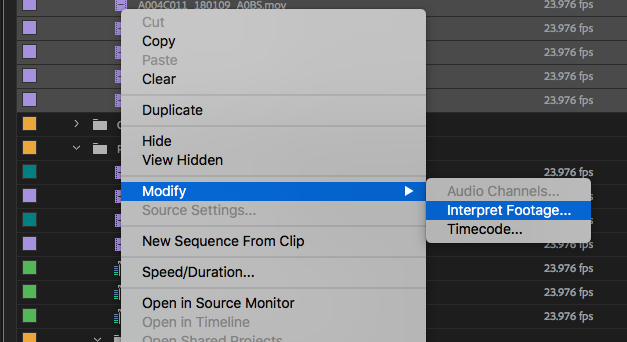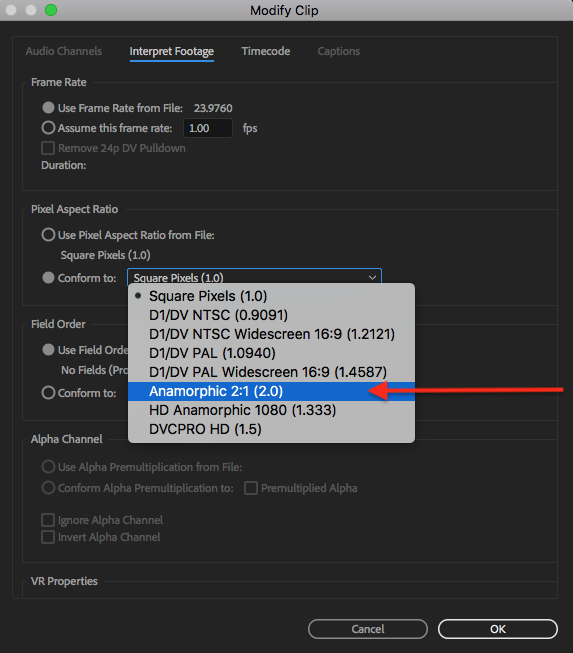 Adobe Community
Adobe Community
Copy link to clipboard
Copied
Hey guys, I'm editing some Arri Anamorphic 2k footage, aspect ratio is 2944 x 2160. If you're familiar with this ratio, you know that once you desqueeze the footage and bring the clips into Premiere, it has extra black padding on the left and right.
What is the proper sequence settings / dimensions I should be editing this footage in?
Here are some options I've come across on message boards:
1) Edit in the native sequence, 2944 x 2160 and scale up the clips to eliminate the extra padding.
2) Edit in 2880 x 2160, no scaling required.
3) Edit in a 2048 x 858 sequence, and scale the clips to fit
My final delivery will be in 1080p, by the way. So, I'd like to edit everything in the high res sequences, lay graphics over the top etc. and then export out at 1080p, unless that's not the best way. Would love to hear suggestions.
Thank you, and sincerely appreciate any help I can get.
 1 Correct answer
1 Correct answer
Ah, I see. Guess I was wondering what the industry standard workflow is when dealing with this 2K, 2944 x 2160 anamorphic footage shot on the alexa mini, when delivering for broadcast at 1080p. Maybe there isn't one? From what I gather, it's pretty much up to me to determine how the end product should be cropped within the 1080 comp.
Copy link to clipboard
Copied
My preference is to edit in a sequence matching the highest resolution needed for delivery, so I'd choose 3.
Copy link to clipboard
Copied
So, for you would that mean taking the 2944 x 2160 clips and scale them down to fit the 1080 comp?
Copy link to clipboard
Copied
Sort of. I'd edit in a sequence at the correct aspect ratio, scaling them down to that (or not, if reframing is needed). The software would add the necessary black bars for 1080 delivery, but still allow a proper "no black" export of 2048 x 848.
Copy link to clipboard
Copied
Ah, so that sort of gets to my other question. Is 2048 x 848 the aspect ratio I should be editing these clips in? I had been editing them in the native 2994 x 2160 sequence, and then scaling them up slightly to get rid of the padding left and right. Editing in a 2048 x 848 sequences, I'd obviously need to scale and adjust the clips a bit more to fit. And exporting out a 2994 x 2160 edit at 1080 vs Exporting out a 2048 x 848 edit at 1080 is going to look different obviously. The former, having a slightly thinner letter box. I don't know which is correct.
Picture attached for reference. The red area indicates a classic 2.39 letterbox area. The video you see in the frame is the full 2994 x 2160 (scaled to get rid of the padding) dropped into the 1080 comp. (white box added to protect the innocent)
Copy link to clipboard
Copied
I found this from a blog on Frame.io ... one of my fav places to get interesting info these days.
To de-squeeze anamorphic footage in Premiere, highlight the clips in question, right click and hover to modify and click on interpret footage.
Once there, under Pixel Aspect Ratio click the Conform to: toggle and select Anamorphic 2:1 in the dropdown menu.
Premiere will then interpret that footage moving forward as anamorphic and it will be de-squeezed. You can do this for all of your footage at once if you have it all imported.
Does this answer your needs?
Neil
Copy link to clipboard
Copied
The footage is already de-squeezed. I don't need to do it. I'm just trying to determine the proper sequence settings to edit my picture in,taking in consideration I'll be delivering for broadcast at 1080. I want to make sure I'm framing the footage correctly etc. and getting the most out the native framing and how it was intended to be viewed.
Copy link to clipboard
Copied
Oh, right. For that question, I've seen several editors with workflows where they used a mask to proportion on a track above the media, but left the media sequence at native pixel dimensions. They could toggle the mask layer on/off at will of course to see what the 'final' would look like. One commented he preferred this to automatically scaling to final as this way he could see exactly where he wanted to scale the underlying clip up/down on the track as it tended to vary per clip, even at times within a clip.
Of course, depending on how well the DOP shot it, it might work to just set per final ratio and auto-scale. With Set To rather than Scale To set as your option in the preferences, you still have scaling after-the-drop as needed.
Um ... that's nice media to work with. Enjoy!
Neil
Copy link to clipboard
Copied
Thanks Neil, appreciate the response! That being said, in the below reference you'll see an image of a 1080 comp. The red matte represents a 2.39 letterbox matte, I think like you were mentioning some editors using, it's just colored red for this demonstration. The video you see is at native pixel dimensions, set to to fit the 1080 comp. I personally don't mind the slightly narrower crop. But I'm guessing it's not best practice to keep the crop that way, but rather scale it up to fit the broader 2.39 mask? I guess I don't understand why the native dimensions are not made to fit the 2.39 crop, if that's the crop that people want to see as the end result. Any thoughts?
made to fit the 2.39 crop, if that's the crop that people want to see as the end result. Any thoughts?
Copy link to clipboard
Copied
Thanks Neil, appreciate the response! That being said, in the below reference you'll see an image of a 1080 comp. The red matte represents a 2.39 letterbox matte, I think like you were mentioning some editors using, it's just colored red for this demonstration. The video you see is at native pixel dimensions, set to to fit the 1080 comp. I personally don't mind the slightly narrower crop. But I'm guessing it's not best practice to keep the crop that way, but rather scale it up to fit the broader 2.39 mask? I guess I don't understand why the native dimensions are not made to fit the 2.39 crop, if that's the crop that people want to see as the end result. Any thoughts?

Copy link to clipboard
Copied
The ones I saw demo'd were a 2:39 or 2:78 crop ... centered vertically in a standard 16:9 sequence, with a 50% grayed image above/below.
Doing the same thing with yours, if you stayed trying to fill height, would be to apply the mask to the middle with the sides grayed ... is that what you're thinking of doing?
Neil
Copy link to clipboard
Copied
I guess what I'm asking is, should I just scale the native clips to fit the 1080 comp, and just apply the 2.39 matte over the top? Just feels like strange workflow. Just don't understand why the clips don't desqueeze to automatically fit the 2.39 crop. The extra step is annoying.
Copy link to clipboard
Copied
Maybe?
I'm still not understanding exactly what you're expecting to end up with ... a long-narrow or standard 16:9 final image/export.
Neil
Copy link to clipboard
Copied
Ah, I see. Guess I was wondering what the industry standard workflow is when dealing with this 2K, 2944 x 2160 anamorphic footage shot on the alexa mini, when delivering for broadcast at 1080p. Maybe there isn't one? From what I gather, it's pretty much up to me to determine how the end product should be cropped within the 1080 comp.
Copy link to clipboard
Copied
Just don't understand why the clips don't desqueeze to automatically fit the 2.39 crop.
Math. The resolution used doesn't "add up" to 2.39 when desqueezed.
You'd have to ask Alexa why they went non-standard.
Copy link to clipboard
Copied
Arri found prores works better in groups of 128 so they black side padded 64 pixels or 32 each side. as a fun note, the anamorphic acts as a pixel ratio converter of x 2. other formats you multiply to get a new AR. cool, huh?
Copy link to clipboard
Copied
Awesome, thanks for all the info guys. One last question I pose. If you guys where in the same situation working with this padded 2K anamorphic material, and you were cutting an ad for broadcast, and also where going to run it on web as well. How would you proceed? Would nest the 2k anamorphic sequence into a 1080 comp and apply a 2.39 mask over the top? Or would you confirm the footage to a anamorphic sequence, that had the appropriate 2.39 aspect ratio, and upon export choose 1920x1090 and scale to fit, so that you end up with a 16x9 export with the appropriate bars top and bottom or lastly would you just export the video with a true 2.39 aspect ratio and deliver that to stations and web, not sure if the web and broadcast stations automatically scale to fit the 16x9 screens.
Copy link to clipboard
Copied
Also, looking to end up with 16x9 final export...but cropped to appear the way it was shot, so it would 16x9 but letter boxed, if that makes sense.
Copy link to clipboard
Copied
you can't change the laws of physics. either crop or pad. two, there are, no more no less.
Aspect Ratio = (Horizontal Resolution / Vertical Resolution) × Pixel Aspect Ratio
so your AR = 2.66666 square
and 16:9 = 1.77 square
if you had to keep AR, 2.6 square would be 1920/720 square pixels or 2k par 2.6 2880x1080.
hdtv is 1920x720 par 2.6 pad or 1920x1080 crop/zoom.
Copy link to clipboard
Copied
jonathand80819138 escribió
it has extra black padding on the left and right.
The sequence is not well configured:
jonathand80819138 escribió
What is the proper sequence settings / dimensions I should be editing this footage in?
In the project panel where the clip is located, right click on the clip and select New clip sequence. With this you configure the correct resolution. If you want a more fluid edition, otherwise it will increase the processing during editing.
jonathand80819138 escribió
My final delivery will be in 1080p,
In Export Settings, you select your preset 1080, and in the export monitor, Output> Source Scaling> Scale to Fill.
Copy link to clipboard
Copied
Regardless of how you perform your de-squeezing, scaling etc. you should probably work in a 1920x1080 sequence - some effects (such as denoising) and text might not render at their best if you are working in a frame size different from your delivery and applying scaling after the fact.
Copy link to clipboard
Copied
On the otherhand if you want to use WS you need to nest.

